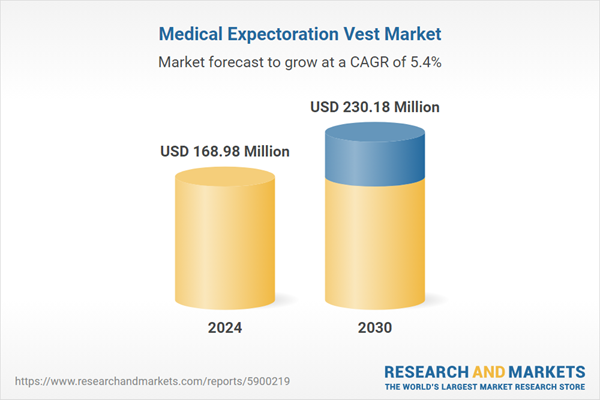Speak directly to the analyst to clarify any post sales queries you may have.
10% Free customizationThis report comes with 10% free customization, enabling you to add data that meets your specific business needs.
The oscillations help mobilize mucus, improving respiratory function and reducing infection risk. This technology is especially beneficial for individuals with cystic fibrosis, bronchiectasis, or other chronic pulmonary conditions. The growing prevalence of respiratory diseases, combined with the increasing need for non-invasive airway clearance solutions, is driving market demand. Innovations in device design, material quality, and integrated smart technologies are further enhancing patient comfort and treatment efficiency, contributing to broader adoption across healthcare settings globally.
Key Market Drivers
Technological Advancements
Technological innovation is a key factor driving the growth of the medical expectoration vest market. Advances in materials, electronics, and digital connectivity have significantly enhanced the design and performance of these devices. New-generation vests are built with lightweight, flexible, and hypoallergenic materials, providing improved comfort and durability for frequent use.Integrated electronic control units equipped with intelligent algorithms offer precise oscillation control, allowing for individualized treatment settings tailored to each patient’s respiratory needs. Additionally, the incorporation of Bluetooth and smart connectivity enables remote monitoring and adjustments through mobile applications, facilitating better patient adherence and clinical oversight. These developments are making expectoration vests more user-friendly and effective, supporting their adoption in both clinical and homecare environments.
Key Market Challenges
Regulatory Complexities
Regulatory complexities present a substantial challenge to the growth and smooth functioning of the medical expectoration vest market. Companies must navigate a wide array of regulatory requirements that vary by region and product type. These include compliance with safety standards, clinical validation protocols, and post-market surveillance obligations.Frequent changes in regulations demand ongoing attention and adaptation, requiring significant resources and specialized expertise. For manufacturers, meeting these evolving standards while maintaining cost-efficiency adds operational pressure. Non-compliance can result in delays, product recalls, and legal liabilities, making robust regulatory planning essential. This complexity can be especially burdensome for smaller firms and new market entrants, potentially limiting innovation and expansion within the sector.
Key Market Trends
Enhanced Safety Features
The emphasis on product safety and consistent quality is emerging as a crucial trend in the medical expectoration vest market. Manufacturers are prioritizing the development of vests that adhere to stringent safety protocols and undergo rigorous quality control during production. Ensuring consistent product performance is critical, especially for devices intended for frequent and long-term use by patients with chronic conditions. Enhanced design features such as secure fastenings, reinforced seams, and ergonomically contoured fits are being introduced to reduce discomfort and improve usability. In addition, companies are investing in safety-focused R&D to prevent malfunction risks, such as irregular oscillation or overheating. The trend toward higher safety standards is aimed at strengthening patient trust, reducing adverse events, and supporting the long-term adoption of these respiratory support devices.Key Players Profiled in this Medical Expectoration Vest Market Report
- Hill-Rom Holdings, Inc
- Electromed, Inc.
- Koninklijke Philips N.V.
- General Physiotherapy, Inc
- Dymedso Inc
- Electromedical Products International, Inc.
Report Scope:
In this report, the Global Medical Expectoration Vest Market has been segmented into the following categories, in addition to the industry trends which have also been detailed below:Medical Expectoration Vest Market, by Type:
- Single Function
- Multifunction
Medical Expectoration Vest Market, by End User:
- Hospitals
- Ambulatory Surgery Centers
- Other End Users
Medical Expectoration Vest Market, by Region:
- North America
- United States
- Canada
- Mexico
- Asia-Pacific
- China
- India
- South Korea
- Australia
- Japan
- Europe
- Germany
- France
- United Kingdom
- Spain
- Italy
- South America
- Brazil
- Argentina
- Colombia
- Middle East & Africa
- South Africa
- Saudi Arabia
- UAE
Competitive Landscape
Company Profiles: Detailed analysis of the major companies present in the Global Medical Expectoration Vest Market.Available Customizations:
With the given market data, the publisher offers customizations according to a company's specific needs. The following customization options are available for the report.Company Information
- Detailed analysis and profiling of additional market players (up to five).
This product will be delivered within 1-3 business days.
Table of Contents
Companies Mentioned
The leading companies profiled in this Medical Expectoration Vest market report include:- Hill-Rom Holdings, Inc
- Electromed, Inc.
- Koninklijke Philips N.V.
- General Physiotherapy, Inc
- Dymedso Inc
- Electromedical Products International, Inc.
Table Information
| Report Attribute | Details |
|---|---|
| No. of Pages | 180 |
| Published | May 2025 |
| Forecast Period | 2024 - 2030 |
| Estimated Market Value ( USD | $ 168.98 Million |
| Forecasted Market Value ( USD | $ 230.18 Million |
| Compound Annual Growth Rate | 5.4% |
| Regions Covered | Global |
| No. of Companies Mentioned | 7 |









